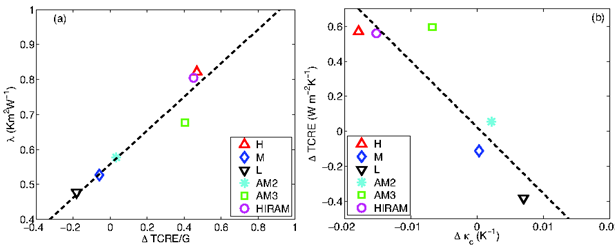Convection and Cloud Feedback Uncertainties
Since the IPCC AR4, GFDL models participating in the IPCC have exhibited fairly large changes in their climate sensitivities. For example, the transient climate response (TCR) increased from 1.5K in CM2 to 2.1K in CM3. Consistently, the equilibrium climate sensitivity (ECS) increased from approximately 3K in CM2 to 4.5K in CM3. These changes are a significant fraction of the inter-model differences in TCR and ECS among all CMIP3 and CMIP5 models. Thus, understanding the causes of changes in
our own models — climate sensitivity is an important step towards identifying the full uncertainty of all IPCC models.
Using the Cess approach (increasing sea surface temperatures uniformly and examining the response in the TOA energy balance) shows (top) the inter-model variation of the GFDL model using the Cess climate sensitivity parameter can be well explained by the cloud feedback (defined here as changes in total CRE), consistent with many earlier studies. Through a series of sensitivity tests, we identified that the changes in the convection parameterization play a dominant role in the changes in the models? cloud feedback.

To provide an in-depth analysis and understanding of the relationship between convection, clouds and cloud feedback, we constructed a bulk diagnostic approach, and derived a set of variables useful in understanding the simulated relationship (Zhao 2014). In particular, we propose a bulk convective detrainment (or precipitation) efficiency as a simple measure of the aggregated properties of parameterized convection important to GCM clouds and cloud feedback. It measures the ability of cumulus convection to generate clouds and moisten the free troposphere per unit precipitation. At the process level, the bulk detrainment efficiency is sensitive to details in the parameterization of cumulus mixing and precipitation microphysics.
To test our understanding of the processes, we use a developmental version of the next generation GFDL model (AM4) to construct three models with drastically different cloud feedback (H, M and L in the figures) with the model differences confined entirely in their formulation of convective precipitation microphysics (Zhao et. al, submitted). The bottom figure shows that the effect can be quantified through the bulk convective detrainment efficiency. Given current uncertainties in representing convective precipitation microphysics, this study suggests that one can engineer climate sensitivity in a GCM without appreciably impacting the quality of the simulation of the climate. In the absence of clear observational constraints on these processes, the implications of having this ability to engineer climate sensitivity needs to be considered when estimating the uncertainty in climate projections.
Publications
- Zhao, Ming, J-C Golaz, I. M. Held, V. Ramaswamy, S-J Lin, Y. Ming, P. Ginoux, B. Wyman, L. J. Donner, D. Paynter and H. Guo, 2015: Uncertainty in model climate sensitivity traced to representations of cumulus precipitation microphysics. Journal of Climate, In press.
- Zhao, Ming, March 2014: An Investigation of the Connections among Convection, Clouds, and Climate Sensitivity in a Global Climate Model. Journal of Climate, 27(5), DOI:10.1175/JCLI-D-13-00145.1.


